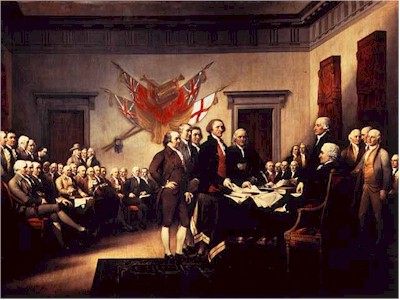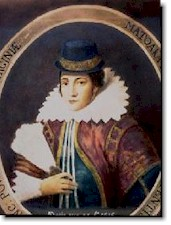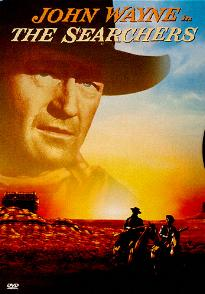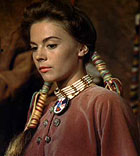
American
Romanticism:
Lecture notes
Pre-Romantic Writings: American Origins
| Presentation schedule
Class format "captivity narratives" +
gothic |
|
Pre-Romantic Writings: American Origins
Thursday 4 September: Columbus, N 24-28; Selections from Genesis (web post); John Smith, N 43-53. Mary Rowlandson, N 117-134. Thomas Jefferson, N 338-346.
text-objective discussion leader: Tanya Stanley
poetry: Anne Bradstreet, “To my Dear and Loving Husband,” N 108.
poetry reader / discussion leader: Matt Richards
Pre-Romantic & Early Romantic Writings
Thursday 11 September: Jonathan Edwards, N 168-170 (introduction), 194-205 (Sinners in the Hands of an Angry God, esp. beginning and end), 170-180 (Personal Narrative); Susanna Rowson, selections from Charlotte Temple: A Tale of Truth (web post); Washington Irving, N 453-466 ("Rip Van Winkle"), "The Legend of Sleepy Hollow" (web post).
text-objective discussion leader:
poetry: James Wright, "A Blessing," N 2613
poetry reader / discussion leader: Donny Wankan
web highlight (midterms): Dawlat Yassin
Instructor's questions for readings:
Columbus:
How do Columbus's letters trace a romance narrative? How are Romanticism and America combined from the first European explorers? How does "Reality" intrude?
Columbus and Genesis:
How does Columbus recreate the Genesis story? (both in text and in popular-historical attitudes toward "discovery of America")
Mary Rowlandson:
How is this "captivity narrative" (i. e., a white settler taken hostage by the Indians) like and unlike a romance?
(Larger purpose of Rowlandson text: Cooper's Last of the Mohicans is a captivity narrative)
Jefferson pp 334-42 (intro and Declaration of Independence)
Compare to Columbus and Genesis as an "origins story" or "creation myth"
What
is Romantic about the Declaration of Independence?
(all 3 aspects of obj. 1: period, style, narrative)
Course Objectives
Objective 1: Literary Categories of Romanticism
-
To identify and criticize ideas or attitudes associated with Romanticism, such as desire and loss, rebellion, nostalgia, idealism, the gothic, the sublime, the individual in nature or separate from the masses.
-
Romance narrative: A desire for anything besides “the here and now” or “reality," the Romantic impulse, quest, or journey involves crossing physical borders or transgressing social or psychological boundaries in order to attain or regain some transcendent goal or dream.
-
A Romantic hero or heroine may appear empty or innocent of anything but readiness to change or yearning to re-invent the self or world.
Objective
1b. The Romantic Period
-
To observe Romanticism’s co-emergence in the late 18th through the 19th centuries with the middle class, cities, industrial capitalism, consumer culture, & nationalism.
-
To observe predictive elements in “pre-Romantic” writings from earlier periods such as “The Seventeenth Century” and the "Age of Reason."
-
To speculate on residual elements in “post-Romantic” writings from later periods incl. “Realism and Local Color,” "Modernism," and “Postmodernism.”
Objective
1c: Romantic Genres
To describe & evaluate leading literary genres of Romanticism:
-
the romance narrative or novel (journey from repression to transcendence)
-
the gothic novel or style (haunted physical and mental spaces, the shadow of death or decay; dark and light in physical and moral terms; film noir)
-
the lyric poem (a momentary but comprehensive cognition or transcendent feeling—more prominent in European than American Romanticism?)
-
the essay (esp. for Transcendentalists—descended from the Puritan sermon?)
Objective 2: Cultural Issues:
America as Romanticism, and vice versa
2a. To identify the Romantic era in the United States of America as the “American Renaissance”—roughly the generation before the Civil War (c. 1820-1860, one generation after the Romantic era in Europe).
2b. To acknowledge the co-emergence and convergence of "America" and "Romanticism." European Romanticism begins near the time of the American Revolution, and Romanticism and the American nation develop ideas of individualism, sentimental nature, rebellion, and equality in parallel.
2c. Racially divided but historically related "Old and New Canons" of Romantic literature:
-
European-American: from Emerson’s Transcendentalism and Fitzgerald’s Jazz Age
-
African American: from the Slave Narratives of Douglass and Jacobs to the Harlem Renaissance of Hughes, Hurston, and Cullen
-
American Indian: conflicted Romantic icon in Cooper and Zitkala-Sa.
-
(Mexican American Literature is not yet incorporated into this course—seminar will discuss.)
2d. Economically liberal but culturally conservative, the USA creates "Old and New Canons" also in terms of gender
-
masculine traditions: freedom and the frontier (with variations)
-
feminine traditions: relations and domesticity (with variations
-
Also consider “Classical” and “Popular” literature as gendered divisions.
2e. American Romanticism exposes competing or complementary dimensions of the American identity: is America a culture of sensory and material gratification or moral, spiritual, idealistic mission?
2f. If "America" and "Romanticism" converge, to what degree does popular American culture and ideology—from Hollywood to human rights—represent a derivative form of classic Romanticism?
class format & possible changes
issue: two potential seating arrangements + balance electronics, print, and speech
graduate seminars traditionally organized so students face each other & instructor sits.
implications of seminar seating:
-
more equality--the romance of the round table!
-
testing out work relative to peers, not just relative to authority figure
-
increasing professionalism (most of you are working, maybe together . . . )
-
student-teacher as master-apprentice, mentor-trainee
But . . .
Introduction of web technology to classroom reshapes seminar
web projector restores traditional, hierarchical classroom: eyes to front!
implications:
positive:
images, sounds, projected notes can reinforce, extend, clarify talking
increased organization, avoid "casual seminar" that may or may not fly
negative:
Authoritative knowledge flows from teacher or class leader
students droop to passive rather than active learning
print texts increasingly idle
lighting a factor?
keyboard power: I already know some answers that I write down > push students toward those answers rather than letting discussions develop
Partial solutions so far
moveable tables and chairs make flexible seating:
past semesters I encouraged students to form a square, but the front-projector eventually overpowered
learned that students as group can't maintain seminar, up to leader
evolving technique: parts of class where I put up questions, then sit down, reorient class so they can see screen and each other
main benefits: disengages from prewritten notes, reinforces equality (sitting > all on same level), opens books
Overall solution: Move back and forth between two classroom organizations.
But what about student presentations?
1. web posting can happen after presentation (in which case presenter leads class without projector, then sends summary for posting)
2. Experiment:
presenter at terminal during presentation
with concluding questions, presenter sits at front or wherever to lead discussion
during discussion, instructor operates terminal / projector
presenter may vary, standing or using blackboard or deposing instructor from terminal
responses / input welcome--
review names
If a problem rises, try to work something out with another student to change assignments, then notify instructor.
Main purpose of presentations is not for you to do a lecture or otherwise show mastery
but to practice seminar-style discussion and leadership.
Mary Rowlandson, N 135-152.
How is this "captivity narrative" (i. e., a white settler taken hostage by the Indians) like and unlike a romance?
(Larger purpose of Rowlandson text: Cooper's Last of the Mohicans is a captivity narrative)
opening page: how would Indians be described today?
contrast Romance
submission
realistic details
myth > history
(reverse history > myth < classical > rom ptgs)
wilderness gothic
cf. Bradford 91
Mather the devil’s territories
High literacy of Puritan women
135 King Philip's War
135 "Indian captivities"
136 Now is the dreadful hour come, that I have often heard of . . . but now my eys see it
137 [proto-gothic] Christians lying in their blood, company of hell-hounds, roaring
138 my mind changed
138 black creatures in the night
138 a lively resemblance of hell
138 vast and desolate wilderness [+ sublime?]
140 [borders of wilderness / borders of consciousness (set up “border romance”)]
141 a Bible
145 cf. Daniel
146 MR’s tendency to read Indians as myth, and our own such tendency
148 granting of desire = end of story, interest
151 I can remember . . .
151 Before I knew what affliction meant, I was ready sometimes to wish for it
romance as separation, not union (till end, happily ever after)
desire
cf Mohicans--what gets left out of wilderness--pain, toothache, misery
but id with Indians
plus tested by wilderness experience
John Smith, N 42-53.
Domestic / wilderness romance as 2 traditions in American novel
what's romantic?
class rise--climbing ladder
captivity and escape
exotic peoples
love of Pocahontas--saving (oneself?) and getting saved
natural abundance--extremes
42 corporate, "company" compromise of government and individual
43 individual initiative and commitment
farmer's son & shopkeeper's apprentice
slave, murdered master
survivor
temper and self-reliance
always at epicenter of political earthquakes
43 harmless adoption ceremony
44 [cf. Smith & Cooper, writing about America from Europe; distance as romanticism; log ago & far away]--"part of imagination"
45 casual reference to god
46 [division of labor]
46 industrial x natural
trade-products [if Romanticism loves nature, key to romanticization of Indian]
48 [Rambo scene]
48 [captivity: why so less affecting than Rowlandson? Single man; cf. Sam Houston)
48 [techno-shock, but geocentric Europeans]
50 hell, devils [ > gothic]
51 as if he had been a monster
51 [rescue scene]
[continuing romanticization, myth-making; change of Smith's age in movie, cf. Change of Hawkeye's age in movies of Mohicans]
Look ahead from Smith:
gender and worldview: Pocahontas and bounty and mercy; pioneers as all-male conquest, invasive force
--conflicting attitudes toward land: spontaneously bountiful or needs to be developed
--captivity narrative (plus deliverance 16): Rowlandson, LOM
enlargement of history into myth (Pocahontas)
survivor as fittest, blest
romanticism: traveler in exotic places, secret papers
survival of fittest x commonwealth
technological superiority -- muskets, compass
novel = roman
Rowlandson published 1682
at this time, only a few novels in existence, not yet widespread, so can't be considered to exist
captivity narratives written in hundreds, over 30 known editions of Rowlandson's
1678-84 Bunyan, Pilgrim's Progress
1719 Defoe, Robinson Crusoe
1740 Richardson, Pamela, or Virtue Reconsidered
as romance narrative
read with same pleasure as novel, fills gap that novel or romance will later fill
desire/quest, goal, journey, crossing borders/boundaries,
changes character
other captivity narratives
Rowlandson, 135 "Indian captivities"
original American narratives: captivity and slave
painful for those who undergo them, but tests and changes people + knowledge of other cultures
prototypes--Babylonian captivity
Last of the Mohicans (1826)
Cynthia Parker (mother of Quannah Parker of Comanche)
Sam Houston
Daniel Boone
hostages, POWs
Patti Hearst
The Searchers
Little Big Man (1970)
Dances with Wolves (?; 1990?)
Ransom
The Missing (2003)
|
|
|
The Searchers was partly based on story of Cynthia Parker?

assignments > midterm preview
Pre-Romantic & Early Romantic Writings
Thursday 11 September: Jonathan Edwards, N 168-170 (introduction), 194-205 (Sinners in the Hands of an Angry God, esp. beginning and end), 170-180 (Personal Narrative); Susanna Rowson, selections from Charlotte Temple: A Tale of Truth (web post); Washington Irving, N 453-466 ("Rip Van Winkle"), "The Legend of Sleepy Hollow" (web post).
poetry: James Wright, "A Blessing," N 2613
poetry reader / discussion leader: Donny Wankan
web highlight (midterms): Dawlat Yassin
Edwards:
"Personal Narrative" (182-194): spiritual romance?
consider how Edwards anticipates Emerson, Romantic attitudes toward nature.
From
Northrop Frye, Anatomy of Criticism.
Princeton, NJ: Princeton University Press, 1957.
In the form in which we possess it, most of [European fiction] has
already moved into the category of romance.
Romance divides into two main forms: a secular form dealing with
chivalry and knight-errantry, and a religious form devoted to legends of saints.
Both lean heavily on miraculous violations of natural law for their
interest as stories. (34)
Edwards, "Sinners in the hands of an Angry God" (just read opening and closing pages): prototypes of gothic and sublime?
Susanna Rowson, Charlotte: A Tale of Truth
1st American bestseller (1790s)--"seduction novel"
"romance" as woman's novel, sentimental novel, tearjerker, loss and reconstruction of family (cf. Rowlandson)
selections--starts in England, ends in America
issues of honor, feeling
Washington Irving, ("Rip Van Winkle"), "The Legend of Sleepy Hollow"
Irving poised between Age of Reason and Romanticism
Age of Reason: satire, humor, detachment
Romanticism:
romance narrative
hero not as leader of society but eccentric, marginalized, outsider
gothic and sublime
esp. relocation of gothic to outdoor environment--compare Smith & Rowlandson
Instructor's questions for readings:
Columbus:
How do Columbus's letters trace a romance narrative? How are Romanticism and America combined from the first European explorers? How does "Reality" intrude?
Columbus and Genesis:
How does Columbus recreate the Genesis story? (both in text and in popular-historical attitudes toward "discovery of America")
Mary Rowlandson:
How is this "captivity narrative" (i. e., a white settler taken hostage by the Indians) like and unlike a romance?
(Larger purpose of Rowlandson text: Cooper's Last of the Mohicans is a captivity narrative)
Jefferson pp 334-42 (intro and Declaration of Independence)
Compare to Columbus and Genesis as an "origins story" or "creation myth"
What
is Romantic about the Declaration of Independence?
(all 3 aspects of obj. 1: period, style, narrative)
Columbus, N ; Selections from Genesis (handout)
Instructor's questions:
How do Columbus's letters trace a romance narrative? How are Romanticism and America combined from the first European explorers?
Columbus and Genesis:
How does Columbus recreate the Genesis story? (both in text and in popular-historical attitudes toward "discovery of America")
Narrative of desire / loss (Poe, Wolfe, Fitzgerald), + Last of the Mohicans, "Rip Van Winkle" (comic form)
Appears so often that, despite content, have to conclude that there's some kind of pleasure in at least reading such a story, even though going through it oneself might be painful
By the end of the semester we'll try to evaluate the aesthetics of this narrative, for now simply observe its existence and a kind of historical basis for it that you can see in Columbus and Rip Van Winkle
Americans always start out in one world and end in another
Romance quest?
As dangerous as promising
Most time, wouldn't take journey if not hopeful
Introduction
25 a brief moment of wonder followed by a long series of disasters and disenchantments
25 the lushness of nature there made him believe himself near Paradise, but that illusion vanished
26 great victory
26 gave the name San Salvador (pre-existing story of sin & redemption)
[biblical pattern of captivity and redemption]
26 so to each one I gave a new name
"Adamic"
American as new Adam (+-Eve) in garden-paradise
26 people without number, but nothing of importance
26 very fertile to a limitless degree
27 thousand kinds and tall
27 never lose their foliage
27 nightingale
[factual error > historical error > myth]
from Letter to Ferdinand and Isabella Regarding the Fourth Voyage (1503)
27 Of [these] lands, I
never think without weeping
27 Exhausted state
28 now all . . . seek permission to make discoveries
28 I was made a
prisoner
28 weep for me
Material opportunity / spiritual or moral decline
Columbus and Genesis:
How does Columbus recreate the Genesis story? (both in text and in popular-historical attitudes toward "discovery of America")
Void, formless > word, order
Paradise > Fall
Blessed oneness with God and Nature, change of state of consciousness (Tree of Knowledge)
Innocence > Sin [ > future Redemption?]
Ignorance > Knowledge [> "fortunate fall?"]
Compare to Club Med, etc.
Thomas Jefferson, N 334-342.
Compare to Columbus and Genesis as an "origins story" or "creation myth"
What
is Romantic about the Declaration of Independence?
(all 3 aspects of obj. 1: period, style, narrative)

How may the Declaration be interpreted as a romance narrative (not only in its text but across American history)?
How is the "American Dream" story embedded in the Declaration?
Who's left out?
summary
Columbus:
Paradise past / present imperfect / future
Smith:
Wilderness romance / captivity
self-made man on the frontier
Bradstreet:
Domestic romance
Rowlandson:
Wilderness romance / realism
woman in frontier romance: victim, or opportunity for equality?
Tendency to interpret all experience in terms of pre-existing narrative
Can others use that narrative?
review "Romanticism" (obj. 1) > "American" (obj. 2)
Last week, familiar review of "Romanticism"
First, it's a big, complicated concept, full of contradictions.
A movement, a style . . .
Can't be easily or quickly defined, but can be described and defended
Concept is still alive in our language and culture, but has become more specific than historical and academic usage
Popular uses:
"How romantic!"
"S/he's a romantic."
"I read a lot of romances--you know, love stories."
Most of us know that "Romanticism" or "the romance narrative" in a classroom like ours are bigger concepts than these usages, but important not to reject these usages--they still connect to Romanticism and "the romance narrative" in some way
Course
Objectives:
Objective 1: Literary Categories of Romanticism
Objective
1a. Romantic Spirit or
Ideology
· To identify and criticize ideas and attitudes associated with Romanticism, such as desire and loss, rebellion, nostalgia, idealism, the gothic, the sublime, the individual in nature or separate from the masses.
· The Romantic impulse may be as simple as a desire for anything besides “the here and now”—or “reality”; thus the quest or journey of the romance narrative involves crossing physical borders or transgressing social or psychological boundaries in order to attain or regain some transcendent goal or dream.
· A Romantic hero or heroine may appear empty or innocent of anything except readiness or desire to change or self-invent.
Objective
1b. The Romantic Period
· To observe Romanticism’s concentration in the late 18th through the 19th centuries and its co-emergence with the rise of the middle class, the city, industrial capitalism, consumer culture, and the nation-state.
· To observe predictive elements in “pre-Romantic” writings from earlier periods such as “The Seventeenth Century” and the "Age of Reason."
· To speculate on residual elements in “post-Romantic” writings from later periods incl. “Realism and Local Color,” "Modernism," and “Postmodernism.”
Objective
1c: Romantic Genres
To describe & evaluate leading literary genres of Romanticism:
·
the romance narrative
or novel (journey from repression to transcendence)
· the gothic novel or style (haunted physical and mental spaces, the shadow of death or decay; dark and light in physical and moral terms; film noir)
Literature as style, form > literature as history, historicism
Europe: late 18th, early 19th century
music: Beethoven, Chopin, Wagner
poetry: Goethe, Hugo, Wordsworth
the novel: the Brontes, Walter Scott, Hugo
Standard dates of English Romanticism:
1789-1832
Standard dates of American Romanticism
mid-19th century; 1820-1860 "American Renaissance"
Generation's lag: implication that America inherits Romanticism from European model
at least partly true
Often overlooked: how much Americans are reading European books, and Europeans are increasingly reading American books (beginning with Irving and Cooper)
Romanticism as transatlantic phenomenon
But since this is American Romanticism,
Can we get beyond American simply inheriting Romanticism from Europe?
Don't go too far . . . obviously concepts like "the Gothic" started in Europe and were redeveloped in America, but . . .
>
How much is America always already Romantic?
Arrangement of course:
First two classes: pre-Romantic writers--1400s to early 1800s
Middle of semester: Romanticism: Cooper, Emerson, Douglass, Poe . . .
End of semester: post-Romantic writers: late 19c Realism (James, Twain); early 20c Modernism (Fitzgerald, Harlem Renaissance)
This week and Sept. 11: pre-Romantic writers
This week's writers all visitors or immigrants from Europe
Romanticism has roots in medieval Europe,
Especially the Romance derives from the medieval romances such as the quest for the Holy Grail
Also some biblical or Judeochristian patterns that correspond to romance
(Ancient Jews as wandering people: exile from Eden > bound for Promised Land; self-invention or transformation as conversion)
Unique contributions by American literature to world literature
Captivity narrative, + slave narrative
Today: two captivity narratives: Rowlandson and Smith
Romance narrative potentially implicit in both the captivity narrative and the slave narrative
Repression>release
Captivity > liberation, redemption
romance narrative is space between these: struggle, quest, journey


